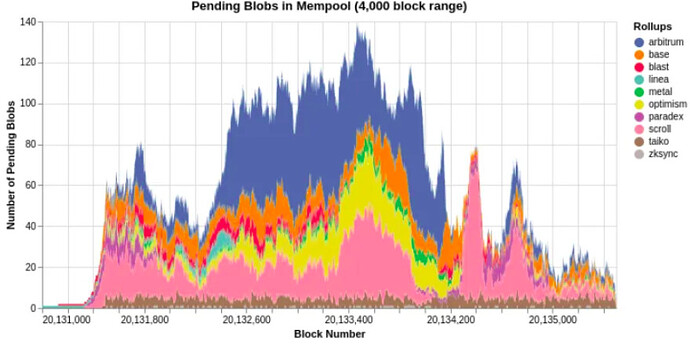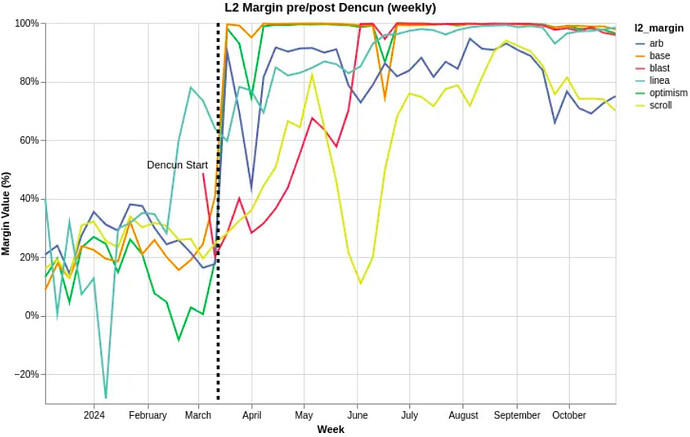Intro
Until recently, the blob market has seen minimal competition, with fees hovering near the base minimum since its inception, interrupted only several times briefly by blob market volatility. However, this past week marked a shift: the blob market has consistently exceeded the target blob count, signaling a tipping point toward prolonged competition.
This shift transitions the blob market from its initial bootstrapping phase to an arena of active competition. We briefly saw the impact at peak blob volatility: inclusion times spiked to over 10 minutes, with rollup costs surging past 15 ETH due to blob slippage. Blob slippage occurs when the blob fee paid exceeds the fee that would have applied if the blob had been included sooner, at a lower rate. The below chart shows thelayer zero airdrop caused severe blob market congestion.
This shift from low competition to a competitive environment not only signals potentially higher fees for builders and providers, but also requires more competitive blob posting strategies to mitigate blob fee slippage. These strategies include increasing priority fees or utilizing preconfirmations to ensure timely blob inclusion.
Blob Market Fees
Builders and Validators profit from blobs only through priority fees, as base fees for execution and consensus are burned. Since Dencun, the blob market has generated approximately $11 million in fees. Priority fees account for only 11.8% of total fees, around $1.3 million cumulative fees. To put this number in perspective, MEV activity generated $2.4 million in tipped fees in the past 7 days, according to libMEV. This comparison highlights that fees generated by the blob market are still nascent to builder and validator revenues.
The chart below shows the cumulative fees generated in the blob market.
The majority of fees, ~89% have come from the base execution and consensus fees, which are burned. As blob market fees influence builder and validator revenue, they also affect the profit margins of major market users, especially L2s.
L2 Margins
The largest Blob market users have been rollups. Transitioning from calldata to the blob market has had an overwhelmingly positive effect on L2 profit margins. The largest L2s have collectively profited $ 19.8 million from switching to the blob market.
The chart below shows that immediately after Dencun, some rollup margins shot up to approximately 99% profit margins with all the rollups in the dataset seeing over 70% profit margins in the past 3 months alone.
In competitive markets, such high profit margins are rare. As more rollups enter the blob market, competition will intensify, compelling rollups to adopt more competitive inclusion strategies to defend their profit margins by securing blob space. This heightened competition is expected to drive down profit margins and generated increased blob market fees.
In contrast, Alphabet’s operating margin is ‘only’ 32%. Operating margins for AWS was 36% and Microsoft Azure was 45% in 2024.
If rollups paid 20% of their historical margins in the form of a higher priority fee, that would have contributed $3.96 million in additional priority fees, increasing builder and validator revenue by 110% while still keeping L2 margins above 50%. This would bring the average priority fee up from 2.8 gwei to 3.36 gwei.
Blob Market Expansion
Efforts to expand the blob market include increasing the max blob count. Based on the current fee breakdown, we can project how a larger blob market—such as an increase from 6 to 12 blobs—might impact revenue. Since 50% of blob market fees come from the execution base fee, which remains steady regardless of congestion, revenue from execution fees could rise from $6 million to $12 million if gas usage stays consistent.
However, the consensus blob base fee and the priority fee, which are more volatile, may behave differently. With the blob base fee remaining at minimal levels for most of the year, it’s likely at its lowest point. Furthermore, EIP 7762 is advocating for a higher minimum base fee, and increased participation from L2s could drive blob fees higher. Already, the blob market has begun approaching a new equilibrium above the minimum fee.
In a very optimistic scenario where the blob market increases to 12 blobs, blobs pay higher priority fees, and there is a higher minimum fee set, we might see blob market fees increase from ~11m to $25 million.
With these factors in play, the future of the blob market points toward greater scalability, yet with possible challenges in balancing competition and profitability.
Data
Data was taken from queries used to create the blob dashboard by the Galaxy Research team and dune-spice by Storm from Paradigm . The notebook used to create the charts can be found here.
Open Questions
- Would validators be more motivated to increase their requirements if they were better compensated? For example, if rollups paid 20% higher priority fees in a competitive market, historical priority fees would have increased from $1.3 million to $3.96 million.
- What do the rollup economics such as profit margins look like for newer rollups such as Taiko?
- What would increasing the min blob fee (EIP 7762) have on blob market economics? Would it create an unfair advantage for rollups that currently have 99% profit margins over others?
- How effectively can preconfirmations mitigate blob fee slippage compared to priority fees?
- Beyond increasing priority fees and preconfirmations, what other methods can L2s employ to optimize their blob inclusion processes and cost structures?



